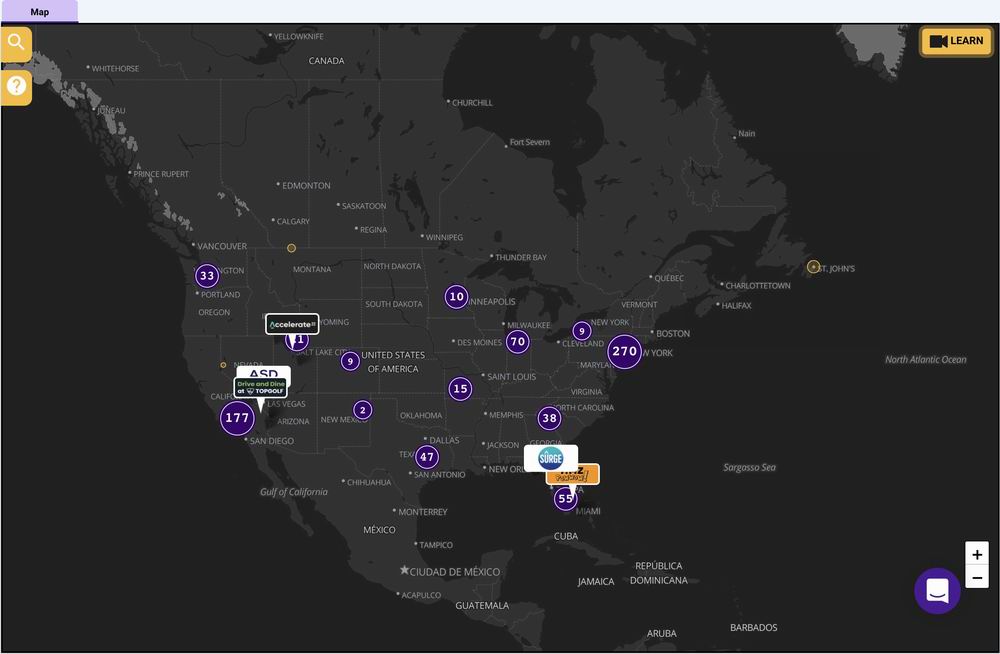Spy On Your Competitors with SmartScout With Michael White
Here at Ritz Momentum, speed is king, and by using the right research tools, we as sellers can gain a huge advantage by moving faster than our competition in one particular phase: product research.
Join Izabella Ritz, CEO of Ritz Momentum, in her discussion with Michael White, Chief Strategy Officer at SmartScout where they cover how to spy on your competition by finding which products are bringing the most revenue for brand wholesale and private label sellers on Amazon, and how to target high demand, low-competition niches.
What is SmartScout?
SmartScout is a software platform that allows us to analyze brand performance, individual products, entire customer journeys, and individual sellers on Amazon.
There are many places to start on the platform, but the one that everyone in the community has talked about is THE MAP. SmartScout has developed a map feature that shows the location of all Amazon sellers as well as their REVENUE. That’s right. You can find individual businesses and discover their performance on Amazon.
But just like any tool, it is best employed when you already have a strategy in mind: a carpenter doesn’t just start using a hammer unless he knows what he is building. Just as we do for our clients at Ritz Momentum, we highly encourage that sellers use the powerful software at their disposal to help them develop and refine their selling strategy, and NOT as some holy grail that will magically produce the business answers for them.
While we don’t want to limit anyone into thinking that they should become either a wholesaler OR a private label seller (because anyone can be both), we will explore SmartScout through these two lens so that we can better understand the tool’s application in finding products that best first our selling strategy. However, one principal certainly applies to both selling types: targeting high-demand, low-competition niches is the only way to gain a lasting competitive edge on Amazon.
Let’s dive in.
How does SmartScout help me find which wholesale products to sell?
- Targeting by Brand Size.A good place to start deciphering with what brands to work is by using the Monthly Revenue Estimate filter to dial in on the brands whose size fits just right for our business. Additionally, we can filter for sellers that have at least 15 brands and 50 products in order to find those strictly wholesaling accounts. The first page will show the highest grossing 1000 brands, so depending on business size, one can skip to the page that’s in the sweet spot.
- Avoid Competing with Amazon.If you really want to go head-to-head with an ecommerce behemoth, go for it…but we highly recommend against it. Using the Amazon In-Stock filter sellers can avoid trying to sell brands that already have a close wholesale relationship with Amazon.
- Remove the FBA Competition.The Average Number of FBA Sellers is our key to finding those competition niches. By setting its maximum to 2, we pinpoint where FBA representation is low, and thus, where competition doesn’t exist.
- Do not target dominant sellers.With the Dominant Seller property, we can filter out any sellers that control more than 50% of a brand’s sales, a clear indication that they have an established relationship with that brand, making competition very difficult, especially for individuals just starting out. Before we build momentum, we have to gain
- Don’t lose your profits in shipping fees.Protect your margins by using Average Product Size to get rid of brands whose product size would cause your shipping and FBA fees to destroy your business model.
*Inside Scoop from Ritz Momentum – We heard that soon SmartScout will include Item Weight into their platform so that we can not only filter by size, but also by weight!
- Target Brands by Product Pricing.By inputting our product’s (or potential product) price into the Average Selling Price filter, we can target brands whose products most closely align with our selling strategy.
This 6-step process may sound tedious and time consuming, but Michael and Izabella were able to go through it simply and clearly in just under 16 minutes. Thanks to SmartScout, research that would previously take hours if not days now takes minutes.
Private Label is where the money is at! How can I use SmartScout to find product opportunities?
Private Label is all about NICHE, and finding high-demand, low-competition products is especially crucial for those establishing their own brands. We can always fix a good product’s bad marketing, but no amount of good marketing will fix a bad product (cough…CNN+…cough).
SmartScout is already set up to help us dive into the depths of Amazon’s entire marketplace.
- Start with Subcategories. In this feature, we can use several filters previously mentioned jointly to isolate the private label sellers that could be our direct competition. When we input our price point into the Average Selling Price, and we enter “2” as the maximum Number of Sellers, we find which private label sellers in the subcategory are selling at the same price point as our selling strategy. While you may be tempted to use the Monthly Revenue Estimate to identify the top performers, remember that the number you see does not tell the whole story: it only shows you the revenue for the subcategory. That brand may have products in other subcategories with varying sales performance, so we need to explore how the whole puzzle fits together if we are going to truly understand our competition.
- Beware of the Shark: Amazon. Remember that Jeff Bezos’s big bad shark lurks everywhere. As we drill down into subcategories, we have to check Amazon’s revenue share percentage to see whether they smell blood in the water; SmartScout makes it easy by displaying the number at a glance.
- Easily make research connections across Amazon. The creative process is iterative: it’s a lot of back and forth, jumping between ideas, and making connections. On SmartScout we can easily navigate and explore Amazon’s 40,000+ subcategories, leaving interesting brands and products open in tabs, connect directly to Amazon with each ASIN’s hyperlink, all while staying organized with their category directory.
- Get the raw product research data. Some people are nerds when it comes to product research, and even though everyone has access to the data, most don’t know how to use it or where to start. At Ritz Momentum, we are guilty as charged when it comes to being #NumberNerds. Once we find our target products, we can export them as an Excel file for even deeper analysis.
How can I spy and take traffic away from competitors?
In our next Amazon Made Simple episode with SmartScout, Izabella will cover how we can use Traffic Graph to figure out where our competitor’s organic traffic is coming from so we can target those products with our own ads. We can then double down on our strategy using AdSpy to gain insight into what keywords our competitors are using in their Pay-Per-Click campaigns, and more importantly, which ones are WINNING.
Where do I go next?
If you want more content like this, subscribe to our podcast, Amazon Made Simple, with Izabella Ritz, and follow us on Instagram.
Click here and use BELLA50 at checkout to get a 7-day free trial AND $50 off your first month’s subscription with SmartScout.
Get out there and make it happen! Happy Amazoning!
We Build High-Profit Amazon Products
That Beat Your Competition.
Guaranteed.

FAQ
Should You Give SmartScout a Try?
Yes, giving SmartScout a try is highly recommended due to its unique and extensive product research tools that set it apart from other Amazon software solutions. By utilizing SmartScout, you will gain access to a wide range of data that can significantly enhance your product research, market analysis, keyword optimization, and competitive strategy development. Signing up for SmartScout will empower you to elevate your research processes and make more informed decisions in your Amazon business endeavors.
Does SmartScout Provide a Demo?
Yes, SmartScout does provide a demo for potential users and buyers. To access the demo, interested individuals can apply by clicking the ‘See a Demo’ button located in the navigation menu on the SmartScout website. Upon filling out a form with the necessary details, the SmartScout team will then respond with further information on how the demo can be accessed.
Does SmartScout Offer a Money-Back Guarantee?
Yes, SmartScout offers a money-back guarantee that is valid for 14 days. Customers have ample time to evaluate the tools and if they are not satisfied, they can request a refund by contacting the customer support team at support@smartscout.com.
What are some alternatives to SmartScout that offer comparable tools and additional features for running an Amazon business?
When looking for alternatives to SmartScout that can provide similar tools and enhanced features for managing an Amazon business beyond product and market research capabilities, it is crucial to consider options that offer a comprehensive suite of tools tailored to various aspects of operating on the platform. Efficient alternatives to SmartScout should not just provide similar product and market research functionalities but also extend their offerings to include tools that aid in other essential components of running an Amazon business effectively. By exploring alternatives that go beyond the basic features of SmartScout and encompass additional functionalities such as inventory management, pricing optimization, competitor analysis, and advertising support, Amazon sellers can benefit from a more robust and all-encompassing solution that caters to their diverse business needs on the platform.
What educational resources does SmartScout offer to Amazon sellers?
SmartScout provides a variety of educational resources for Amazon sellers to enhance their knowledge and skills. These resources can be accessed by clicking on the “Resources” button in the navigation menu. Here is an overview of the educational resources available:
1. SmartScout University: This feature offers a series of instructional videos that aim to educate users on utilizing SmartScout tools effectively across various business models. The videos cover topics relevant to resellers and private label sellers. Additionally, there are Spanish language videos available for those who prefer or are native speakers of Spanish.
2. Industry Reports: SmartScout’s industry reports are valuable resources that offer the latest market and product research analytics. These reports provide insights into current macro-trends, enabling sellers to stay informed about trending industries.
3. Seller Key Terms: For individuals new to the Amazon selling space, the Seller Key Terms glossary serves as a useful resource to help understand common jargon used on the platform. This section can be referred to by beginners when encountering unfamiliar terminologies.
4. SmartScout Blog: The blog section of SmartScout features articles covering various aspects of Amazon FBA. These articles address common queries, offer solutions to challenges, and provide strategies to help sellers optimize their Amazon businesses.
By availing themselves of these educational resources, Amazon sellers can leverage SmartScout’s expertise and support to enhance their understanding and proficiency in navigating the e-commerce landscape effectively.
What SmartScout pricing plans are available and what features do they offer?
SmartScout offers four pricing plans tailored to cater to Amazon sellers of varying budgets and experience levels. These plans include Basic, Essentials, Business, and Enterprise, each offering a unique set of features and benefits to meet the specific needs of users.
The Basic plan is designed for users looking for essential tools and features, while the Essentials plan offers more comprehensive features such as brand research, product research, and a sales estimator. Moving up to the Business plan provides additional benefits like increased UPC scans, access to categorical research, and a keyword rank tracker. The Enterprise plan, with its custom pricing, offers the most extensive range of features, including customer buying patterns, shared keywords by brands and products, customer reporting with excel exports, and unlimited custom markets.
Users can choose a plan based on their budget and requirements, allowing them to access tools and insights that can help optimize their Amazon selling strategies effectively.
Which SmartScout pricing plan is best suited for new sellers, resellers, brands, and agencies?
Which SmartScout pricing plan is best suited for growing brands, experts, and agencies?
The Enterprise plan is the best choice for growing brands, experts, and agencies. It offers all features, including brand & product ad tracking and up to 2 years of historical data. The Enterprise plan is designed for those who want every tool available and require comprehensive market research capabilities tailored to their agency’s size and needs. To obtain pricing details, one needs to contact the SmartScout sales team for a customized quote.
Which SmartScout pricing plan is best suited for Amazon brands?
The Business package is ideal for Amazon brands that have scaled their business and want to continue growing by finding new products. It helps in analyzing market trends, outperforming competitors, and discovering profitable keywords. The Business plan includes 100,000 monthly UPC scans, allowing ample opportunities to find new product-selling chances.
Which SmartScout pricing plan is best suited for Amazon resellers and private label sellers?
The Essentials package is recommended for Amazon resellers and private label sellers. It provides more robust product research tools, including powerful keyword, market, and competition research tools. It also increases the monthly UPC scan limit from 5K to 50K, offering more freedom to find multiple products without limitations.
Which SmartScout pricing plan is best suited for new Amazon sellers?
The Basic package is best suited for new Amazon sellers as it offers enough tools for finding their first product and serves as a good starting point to learn simple product research strategies. However, it does not include market, competition, and keyword research tools.Izabella Ritz, CEO of Ritz Momentum, discusses the SmartScout pricing plans and which one is best suited for new sellers, resellers, brands, and agencies. She states,Click here and use BELLA50 at checkout to get a 7-day free trial AND $50 off your first month subscription with SmartScout.
When considering which SmartScout pricing plan is the most suitable for your needs, it’s essential to delve into the specifics of each option. The Basic package is ideal for new sellers looking to dip their toes into product research, while the Essentials package caters more towards Amazon resellers and private label sellers seeking robust tools for market and competition research. If you are a growing brand or agency aiming to scale your business, the Business plan offers advanced features to help you stay ahead of the competition. For those seeking the ultimate comprehensive package with brand and product ad tracking, the Enterprise plan is the top choice, tailored for agencies and growing brands. Remember to use the code BELLA50 for a special offer on your SmartScout subscription.



